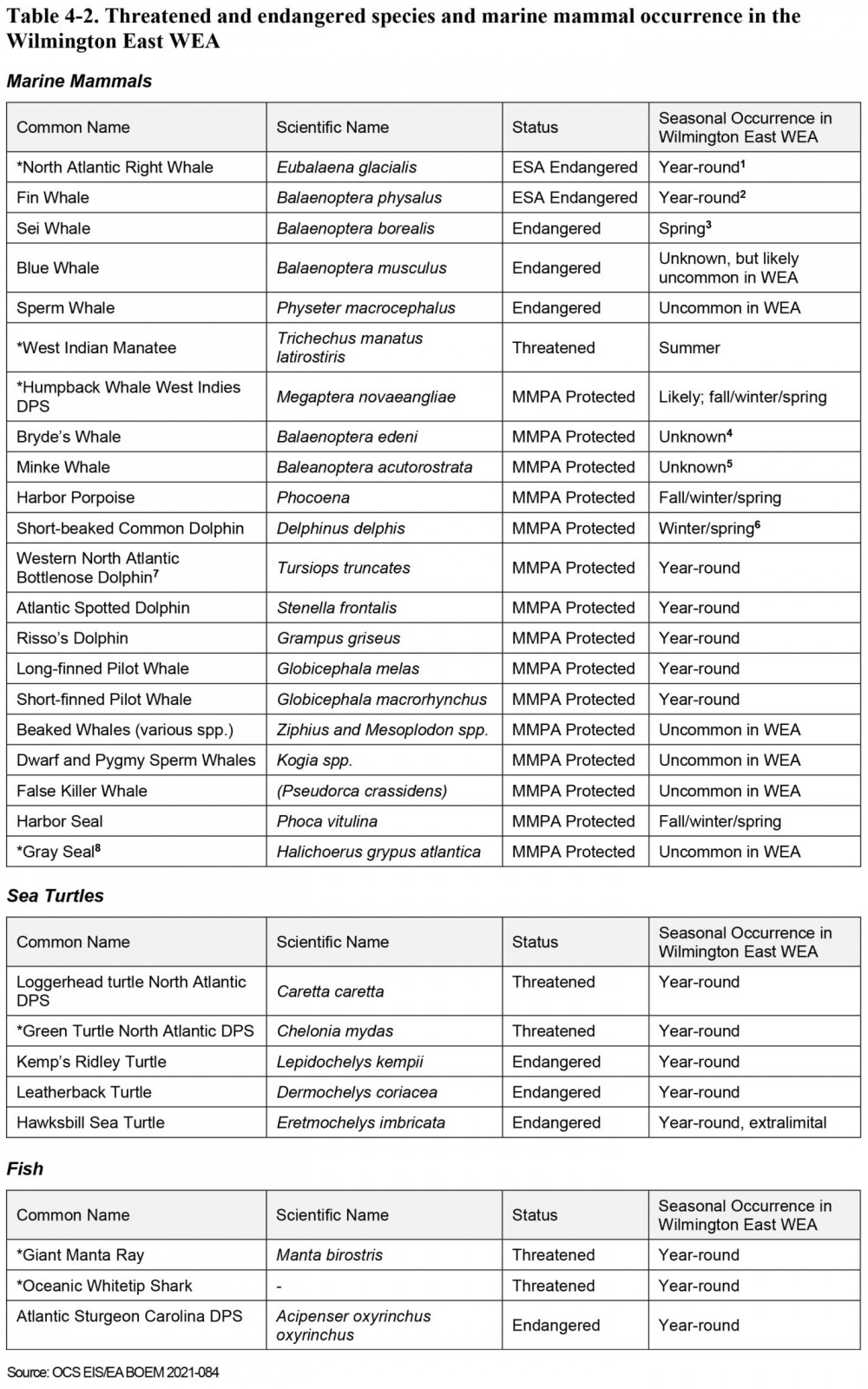In Difficult Times Good People gravitate towards Absolute Truth
How Much Does Offshore Wind Power Threaten Critically Endangered North Atlantic Right Whales?
Publisher's Note: This post appears here courtesy of the John Locke Foundation. The author of this post is Jon Sanders.
It has long been known that development of offshore wind energy facilities pose mortality risks to whales, sea turtles, and other marine species, including especially the endangered North Atlantic Right Whale. In 2017 the National Oceanic and Atmospheric Administration (NOAA) Fisheries declared the whales to be in an Unusual Mortality Event, with an estimated population of "fewer than 500." The most recent estimate is about 30 percent lower: "fewer than 350."
Nevertheless, under a presidential administration bent on greatly increasing offshore wind capacity, the federal government has been loath to investigate the extent of the dangers. So a senior consultant for the U.S. Department of Energy has taken it upon himself to outline how the federal government should study the issue.
Listing threatened species, then downplaying the threats
According to the U.S. Bureau of Ocean Energy Management (BOEM), developing offshore wind energy facilities off the Brunswick County beaches would impact these endangered creatures:

Nevertheless, in 2021 Pres. Joe Biden came into office with an aggressive political goal of "rapid offshore wind development." So BOEM in the Biden administration downplays the risks for the political "win" of offshore wind.
The very fact that the Biden administration has approved the Wilmington East wind energy area (WEA) for development shows an indifference to many endangered species, especially the North Atlantic Right Whale. Part of the reason why is that the federal government had administratively "relocated" the whales. BOEM cited as "new information" since 2015 that NOAA Fisheries under the Obama administration had "issued a final rule in 2016 to replace the critical habitat for right whales in the North Atlantic with two new areas. ... The new critical habitat areas do not fall within the proposed lease area" of Wilmington East.
BOEM also revised the "survival mechanism parameter" in its modeling to "predict a small population size" and its density modeling to reflect that while the whales in the Wilmington East WEA "may potentially occur year-round ... their overall monthly seasonal densities are anticipated to be low."
Calling the North Atlantic Right Whale "endangered" gives a moral impetus for protecting them. On the other hand, saying there aren't that many anyway and there may only be a few in the area at any particular time suggests the whales aren't so big of a deal as to stop what the administration desperately desires.
BOEM in 2015 had listed the limited research findings of several dangers to whales and other marine mammals off North Carolina shores from pile-driving, which is necessary to build the enormous piles that are critical to support the massive turbine towers arrayed across vast stretches of ocean for these offshore wind energy facilities. They included:
BOEM stated that, "There could be potential effects on marine mammals from pile driving, loss of water column habitat, prey abundance and distribution effects, and tower decommissioning." Still, the federal agency decided to deem the anticipated effects from pile driving activities to be "moderate." The term somehow amounted to a green light for developing wind energy facilities off the shores of Brunswick County, but given that several marine mammals expected to be affected - including the North Atlantic Right Whales - are endangered, it's not sufficient.
How to estimate whale deaths related to offshore wind development
This problem also afflicts other U.S. wind energy areas in various stages of development. Federal incaution over it worried Dr. David Wojick, a part-time Senior Consultant for Innovation at the Office of Scientific and Technical Information in the DOE's Office of Science. Wojick recently published an outline at the Center For A Constructive Tomorrow (CFACT) for how the federal government should estimate whale deaths related to offshore wind development, showing also how simple the approach could be.
In discussing the need for the study, however, Wojick charged that the feds were unwilling to undertake such a study "because it would give numbers to the deaths that are likely to occur, species by species."
Wojick cited BOEM's discussion of impacts of undersea pile-driving activity on whales for the proposed Empire Wind project off the New York and New Jersey coast (emphasis added):
It is possible that pile driving could displace animals into areas with lower habitat quality or higher risk of vessel collision or fisheries interaction. Multiple construction activities within the same calendar year could potentially affect migration, foraging, calving, and individual fitness. The magnitude of impacts would depend upon the locations, duration, and timing of concurrent construction. Such impacts could be long term, of high intensity, and of high exposure level. Generally, the more frequently an individual's normal behaviors are disrupted or the longer the duration of the disruption, the greater the potential for biologically significant consequences to individual fitness. The potential for biologically significant effects is expected to increase with the number of pile-driving events to which an individual is exposed.
Given that those impacts on endangered and other species are still largely unstudied, and for Wilmington East dismissed as "negligible" or even up to "moderate" by the Biden administration, Wojick's proposed study would fill in a critical gap:
For every wind project activity that produces excessive underwater noise, [the National Marine Fisheries Service] estimates the number of critters, by species, that will experience unsafe noise levels. They call this experience of unsafe noise a harassment. For some projects, the number of predicted harassments is hundreds for whales and thousands for smaller protected mammals like dolphins and seals. ...
[T]he basic idea is simple enough. First, figure how the excessive noise will be distributed in the ocean. Then given the estimated population density of critters within that noise distribution, calculate the number of animals hit with excessive noise.
As the quote [from BOEM] above makes clear, harassment can cause deadly behavior. The Feds do not address this issue, which is simply the likely death rate of harassment.
Wojick's five-step study outline would proceed from information gathering on harassment estimates to avoidance behaviors, ship traffic and data (vessel strike threats), and then death estimates. On the back end, it would involve data refinement for better estimating. Furthermore, as he pointed out, the methodology could also be used for estimating impacts on migration, foraging, and other impacts warned about.
Even if the Biden administration would prefer not to have this information, it's something North Carolina policymakers should demand.
Go Back
- Since 2017, the population of North Atlantic Right Whales has declined by 30 percent
- By allowing offshore wind energy development off the North Carolina coast, the federal government has pushed aside its own concerns about impacts on endangered whales and other marine species
- A concerned senior consultant for the Energy Department recently outlined how the government should study and estimate whale deaths from offshore wind development
It has long been known that development of offshore wind energy facilities pose mortality risks to whales, sea turtles, and other marine species, including especially the endangered North Atlantic Right Whale. In 2017 the National Oceanic and Atmospheric Administration (NOAA) Fisheries declared the whales to be in an Unusual Mortality Event, with an estimated population of "fewer than 500." The most recent estimate is about 30 percent lower: "fewer than 350."
Nevertheless, under a presidential administration bent on greatly increasing offshore wind capacity, the federal government has been loath to investigate the extent of the dangers. So a senior consultant for the U.S. Department of Energy has taken it upon himself to outline how the federal government should study the issue.
Listing threatened species, then downplaying the threats
According to the U.S. Bureau of Ocean Energy Management (BOEM), developing offshore wind energy facilities off the Brunswick County beaches would impact these endangered creatures:

Nevertheless, in 2021 Pres. Joe Biden came into office with an aggressive political goal of "rapid offshore wind development." So BOEM in the Biden administration downplays the risks for the political "win" of offshore wind.
The very fact that the Biden administration has approved the Wilmington East wind energy area (WEA) for development shows an indifference to many endangered species, especially the North Atlantic Right Whale. Part of the reason why is that the federal government had administratively "relocated" the whales. BOEM cited as "new information" since 2015 that NOAA Fisheries under the Obama administration had "issued a final rule in 2016 to replace the critical habitat for right whales in the North Atlantic with two new areas. ... The new critical habitat areas do not fall within the proposed lease area" of Wilmington East.
BOEM also revised the "survival mechanism parameter" in its modeling to "predict a small population size" and its density modeling to reflect that while the whales in the Wilmington East WEA "may potentially occur year-round ... their overall monthly seasonal densities are anticipated to be low."
Calling the North Atlantic Right Whale "endangered" gives a moral impetus for protecting them. On the other hand, saying there aren't that many anyway and there may only be a few in the area at any particular time suggests the whales aren't so big of a deal as to stop what the administration desperately desires.
BOEM in 2015 had listed the limited research findings of several dangers to whales and other marine mammals off North Carolina shores from pile-driving, which is necessary to build the enormous piles that are critical to support the massive turbine towers arrayed across vast stretches of ocean for these offshore wind energy facilities. They included:
- "behavioral changes, masking of inter- and intra-specific calls, and disruption of echolocation capabilities"
- "avoidance of or flight from the sound source, avoidance of feeding habitat, changes in breathing patterns, or changes in response to predators"
- "physiological effects such as temporary threshold shift and permanent threshold shift" (i.e., inner ear damage and hearing loss)
- "behavioral disturbance ... up to approximately 50 km (30 nm) away from the source, and potential injury such as permanent or temporary threshold shifts ... within 328 feet (100 meters) of the source."
BOEM stated that, "There could be potential effects on marine mammals from pile driving, loss of water column habitat, prey abundance and distribution effects, and tower decommissioning." Still, the federal agency decided to deem the anticipated effects from pile driving activities to be "moderate." The term somehow amounted to a green light for developing wind energy facilities off the shores of Brunswick County, but given that several marine mammals expected to be affected - including the North Atlantic Right Whales - are endangered, it's not sufficient.
How to estimate whale deaths related to offshore wind development
This problem also afflicts other U.S. wind energy areas in various stages of development. Federal incaution over it worried Dr. David Wojick, a part-time Senior Consultant for Innovation at the Office of Scientific and Technical Information in the DOE's Office of Science. Wojick recently published an outline at the Center For A Constructive Tomorrow (CFACT) for how the federal government should estimate whale deaths related to offshore wind development, showing also how simple the approach could be.
In discussing the need for the study, however, Wojick charged that the feds were unwilling to undertake such a study "because it would give numbers to the deaths that are likely to occur, species by species."
Wojick cited BOEM's discussion of impacts of undersea pile-driving activity on whales for the proposed Empire Wind project off the New York and New Jersey coast (emphasis added):
It is possible that pile driving could displace animals into areas with lower habitat quality or higher risk of vessel collision or fisheries interaction. Multiple construction activities within the same calendar year could potentially affect migration, foraging, calving, and individual fitness. The magnitude of impacts would depend upon the locations, duration, and timing of concurrent construction. Such impacts could be long term, of high intensity, and of high exposure level. Generally, the more frequently an individual's normal behaviors are disrupted or the longer the duration of the disruption, the greater the potential for biologically significant consequences to individual fitness. The potential for biologically significant effects is expected to increase with the number of pile-driving events to which an individual is exposed.
Given that those impacts on endangered and other species are still largely unstudied, and for Wilmington East dismissed as "negligible" or even up to "moderate" by the Biden administration, Wojick's proposed study would fill in a critical gap:
For every wind project activity that produces excessive underwater noise, [the National Marine Fisheries Service] estimates the number of critters, by species, that will experience unsafe noise levels. They call this experience of unsafe noise a harassment. For some projects, the number of predicted harassments is hundreds for whales and thousands for smaller protected mammals like dolphins and seals. ...
[T]he basic idea is simple enough. First, figure how the excessive noise will be distributed in the ocean. Then given the estimated population density of critters within that noise distribution, calculate the number of animals hit with excessive noise.
As the quote [from BOEM] above makes clear, harassment can cause deadly behavior. The Feds do not address this issue, which is simply the likely death rate of harassment.
Wojick's five-step study outline would proceed from information gathering on harassment estimates to avoidance behaviors, ship traffic and data (vessel strike threats), and then death estimates. On the back end, it would involve data refinement for better estimating. Furthermore, as he pointed out, the methodology could also be used for estimating impacts on migration, foraging, and other impacts warned about.
Even if the Biden administration would prefer not to have this information, it's something North Carolina policymakers should demand.























